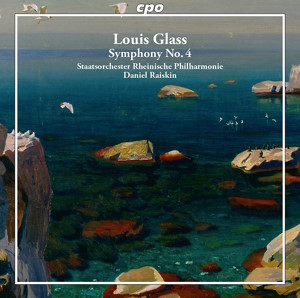
Louis Glass (1864-1936)
Symphony No.4 in E minor, Op.43 (1908)
Staatsorchester Rheinische Philharmonie/Daniel Raiskin
rec. 2014, Rhein-Mosel-Halle, Koblenz
CPO 777 898-2 [54]
CPO’s cycle of Louis Glass’ recordings has reached volume 3, which contains Symphony No.4. Years ago, Danacord recorded Glass’ music and their recording from Plovdiv was reviewed on this site (review). In his notes to this current release Claus Røllum-Larsen mentions that the symphony lasts an hour, which happens to be the timing of the Plovdiv recording, but CPO’s lasts only 54 minutes: not a major difference, it’s true, but still worthy of note.
Composed in 1908 but not premiered until 1911, this is a strong example of Danish late-Romanticism, cast in four movements. It opens with a kind of recitative before Glass unleashes a striding theme with little pastoral elements appearing in the winds – maybe reminiscent of the Forest Symphony, his Third. He is a clever orchestrator, and expert in his use of lower brass which anchors orchestral sonority. Thematically he is also capable of strong ideas, though to me they are rather stop-start. A contemporary critic spoke of the symphony as being abrupt, and I’d agree with that. A firefly Tarantella follows, a scherzo with a massively contrastive B section dripping with warmth, a plangent harp adding romantic lustre, before returning to the opening vitality. Here Glass’s use of strong dynamics has been well understood by Daniel Raiskin, though whether Glass loves that B section a little too unwisely is a matter best left to the individual listener.
It’s the Adagio that sits at the heart of the symphony. Glass certainly knew his Mahler – it’s possible that he was in attendance when a four-hand version of the Second Symphony was given in 1897. There is certainly something Mahlerian about elements of this movement, which is sustained at a slow tempo, and which is exceptionally attractive. It, too, bears contrasts which in Glass’ case are exaggerated almost to breaking point – here it’s in the form of a brass and percussion-bound flurry, lower brass straining like an organ pedal. Thereupon the music opens with a flourishing nobility that’s almost operatically vocalised in its opulence, before returning to the consoling Mahlerian opening.
If the finale disappoints – and it does disappoint, let’s not pretend otherwise – it wouldn’t be the first symphony to have a weak finale. Still, it does have a rip-roaring element that at least provides excitement even though it is hardly a suitable summation to to that gripping Adagio.
Recorded back in 2014, the Staatsorchester Rheinische Philharmonie plays what must have been unfamiliar music with confidence and finesse; some of the wind solos are exemplary and the orchestral verticality, right to the weighty lower brass and bass, is wholly apropos. Raiskin directs finely, and more quickly and incisively than the competition.
The Fifth is a more complete symphonic statement than the Fourth and is probably the place to start if you’re coming fresh to Glass’s symphonies; there’s a fine broadcast from Launy Grøndahl (review) in the mid-50s but the most obvious place to start is CPO’s own version (review).
Even so, you won’t be disappointed by Raiskin’s creative decision-making and his orchestra’s expressive commitment in the Fourth.
Jonathan Woolf
Help us financially by purchasing from





















